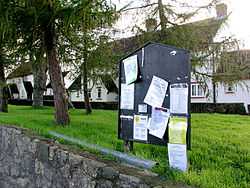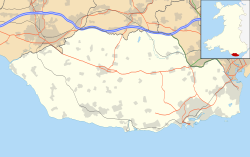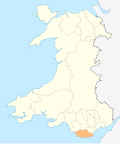Michaelston-le-Pit
| |
|---|---|
 Michaelston-le-Pit Village Green | |
Location within the Vale of Glamorgan | |
| OS grid reference | ST152730 |
| Principal area | |
| Preserved county | |
| Country | Wales |
| Sovereign state | United Kingdom |
| Postcode district | CF |
| Police | South Wales |
| Fire | South Wales |
| Ambulance | Welsh |
| UK Parliament | |
| Senedd Cymru – Welsh Parliament | |

Michaelston-le-Pit (Welsh : Llanfihangel-y-pwll) is a village in the Vale of Glamorgan, just to the west of the city of Cardiff, Wales. It is part of the Michaelston-le-Pit and Leckwith community. The community population taken at the 2011 census was 309. [1]
Contents
To the south lies the town of Penarth, while to the south west lies the village of Dinas Powys. The Cwrt-yr-Ala estate stands to the west. The ancestral home of the Rous and Brain families, the estate was bought in the early 20th century by Sir Herbert Merrett, a Cardiff industrialist. In 1939, Merrett commissioned Percy Thomas to build him a new home on the site. Cwrt-yr-Ala House is a Grade II listed building and its gardens and grounds are listed, also at Grade II, on the Cadw/ICOMOS Register of Parks and Gardens of Special Historic Interest in Wales. [2] [3]
The village is built near the confluence of two small streams, which join to form the Cadoxton River. The French suffix is possibly derived from a clay pit near the southern end of the village, it having been settled on a Norman family, the De Raneghs, after the conquest.
Llanfihangel-y-pwll means The Church of St Michael and All Angels of the Pool or Pit. It is not to be confused with Latin suffixed Michaelston-super-Ely (Cardiff) or Welsh suffixed Michaelstone-y-Fedw (Newport).

